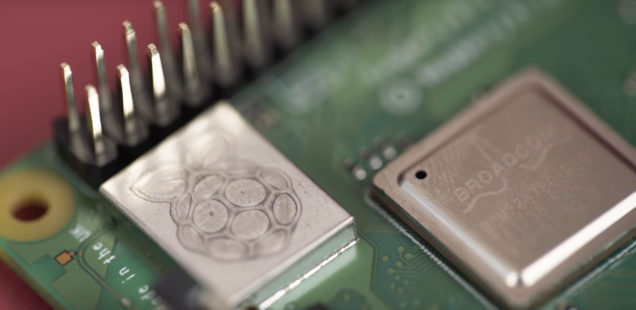
Raspberry Pi 4B and 3B+ in comparison
Completely surprisingly and without prior notice, the Raspberry Pi 4 was introduced in June 2019. In May 2019, Raspberry Pi founder and CEO Eben Upton had still been talking about the Raspberry Pi 4 and mentioned a realistic release date in the second half of 2020. This was probably a wrong track and Upton had everyone fooled as far as the date was concerned.
The Raspberry Pi 4 has the same dimensions as its predecessor. The board is fully HAT compatible, so the dimensions and holes are the same as the previous models. This means that existing plug-in modules can still be used. However, since new connections and positions have been made when assembling ports, the previous housings can no longer be used with the RPi4.
In direct comparison to its predecessor, the Raspberry Pi 4 has under the hood a lot of changes. The Raspberry Pi 4 is now available for the first time in three different versions with regard to RAM. In addition, the performance of SoC, USB and Ethernet has been significantly improved. Many had been waiting for this eagerly.
Technical differences
| RPi 4 | RPi 3 B+ | |
|---|---|---|
| Release | June 2019 | March 2018 |
| Dimensions | 85,6 × 56mm | 85,6 × 56mm |
| SOC | BCM2711 New | BCM2837 |
| CPU | ARM Cortex-A72 (ARMv8-A) New |
ARM Cortex-A53 (ARMv8-A) |
| CPU-Cores | 4 | 4 |
| CPU-clock | 4x 1500 MHz New | 4x 1400 MHz |
| RAM size | 1024 MB 2048 MB New 4096 MB New |
1024 MB |
| RAM-Type | LPDDR4 New | LPDDR2 |
| USB | 2x USB3.0 New 2x USB2.0 |
4x USB2.0 |
| Video | 2x Micro HDMI New | 1x HDMI |
| Network | Echtes Gbit Ethernet New | Gbit Ethernet (max. 300 Mbit/s) |
| Wifi | 2,4/5 GHz wifi ac | 2,4/5 GHz wifi ac |
| Bluetooth | Bluetooth 5.0 New | Bluetooth 4.2 |
| GPIO | 40 Pins | 40 Pins |
| PoE | ja | ja |
| Power consumption |
max. 7,6 W 4,4 W (Idle) |
max. 7,0 W 3,1 W (Idle) |
| Power source | 5V USB-C min. 2,5 A New |
5V Micro USB min 2,5 A |
| Price | ca. 38 – 58€ | ca. 32€ |
| Shop | Shop |
What new features brings the Raspberry Pi 4B?
- Faster network
Now “real” Gigabit Ethernet is finally supported. Although the predecessor was also advertised with Gigabit-Ethernet, real was finished at about 300 MBit/s. The reason for this was that the chip was internally attached to a USB 2.0 controller. With RPi4 this is now a thing of the past and the performance of the Gigabit Ethernet interface has tripled. - Higher CPU clock
The four ARM cores were also improved. These now clock with 1.5 GHz instead of 1.4 GHz. The latest version of the Raspberry Pi 4 uses a Broadcom BCM2711 chipset. Compared to the predecessor model, the performance of the chip is said to have tripled. - Memory / RAM
There has been a big leap in RAM performance. Where previously only 1GB was available, the RPi4 is now available in three different RAM versions (1GB, 2GB, 4GB). In contrast to the Raspberry Pi 3B+, which still relies on LPDDR2 SDRAM, the Raspberry Pi 4 has much faster LPDDR4 SDRAM installed. - connections
Probably the most striking new feature is the two micro HDMI ports, which are available for video and sound (support for up to 4kp60 or dual dual 4kp30). In addition, real Gbit Ethernet and USB 3.0 with two ports is finally on board. Last but not least, the RPI4 is no longer powered by Micro-USB, but by a USB-C port. So you need a new power supply, or at least an appropriate adapter. - Case
As mentioned above, the connections and positions of the ports have changed on the Raspberry Pi 4. Therefore the previous housings (2B – 3B+) can no longer be used with the new RPi4.
My conclusion
The Raspberry 4 is an impressive upgrade and contains long awaited hardware improvements that many, including me, have been waiting for. But not everyone will like the changes that come with it, because inevitably new accessories (case, power supply, HDMI cable/adapter) will be required due to the changed connections.
Another dark side can be the power consumption, depending on the application. Because more power and faster connections are of course also more power-hungry. In comparison to the predecessors, the power consumption, especially idle, has increased significantly as a result. If the focus is on performance or high network throughput, such as in a media center or small server, the new Raspberry Pi 4B will clearly be the best choice. If, on the other hand, a power-saving system is required, then it is worth taking a look at the previous models. Especially the Raspberry Pi 3B (not 3B+), with max. 4.4 watts under load instead of 7.6 watts for the RPi4, may be the better choice for small, power-saving control tasks.


Another thing is that the USB-C power connection can be used for power AND data transfer, if one changed a “BIOS” setting. Works great with Nxt 2 screen/keyboard/battery combo. Which make it possible to use only two wires not. One for HDMI and one for power/USB for the keyboard/mouse/SD-card reader.
So that is also something that is nice with the new hardware.